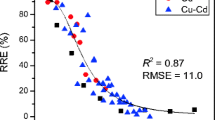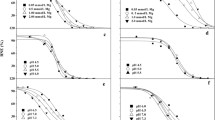Abstract
Background and aims
The biotic ligand model (BLM) is a bioavailability model for metals based on the concept that toxicity depends on the concentration of metal bound to a biological binding site; the biotic ligand. Here, we evaluated the BLM to interpret and explain mixture toxicity of metals (Cu and Zn).
Methods
The mixture toxicity of Cu and Zn to barley (Hordeum vulgare L.) was tested with a 4 days root elongation test in resin buffered nutrient solutions. Toxicity of one toxicant was tested in presence or absence of a low effect level of the other toxicant or in a ray design with constant toxicant ratios. All treatments ran at three different Ca concentrations (0.3, 2.2 and 10 mM) to reveal ion interaction effects.
Results
The 50 % effect level (EC50) of one metal, expressed as the free ion in solution, significantly (p < 0.05) increased by adding a low level effect of the other metal at low Ca. Such antagonistic interactions were smaller or became insignificant at higher Ca levels. The Cu EC10 was unaffected by Zn whereas the Zn EC10 increased by Cu at low Ca. These effects obeyed the BLM combined with the independent action model for toxicants.
Conclusions
The BLM model explains the observed interactions by accounting for competition between both metals free ions and Ca2+ at the Cu and Zn biotic ligands. The implications of these findings for Cu/Zn interactions in soil are discussed.




Similar content being viewed by others
References
Backhaus T, Faust M (2012) Predictive environmental risk assessment of chemical mixtures: a conceptual framework. Environ Sci Technol 46(5):2564–2573. doi:10.1021/es2034125
Backhaus T, Altenburger R, Boedeker W, Faust M, Scholze M, Grimme LH (2000) Predictability of the toxicity of a multiple mixture of dissimilarly acting chemicals to Vibrio fischeri. Environ Toxicol Chem 19(9):2348–2356. doi:10.1897/1551-5028(2000)019<2348:pottoa>2.3.co;2
Berenbaum MC (1985) The expected effect of a combination of agents - the general solution. J Theor Biol 114(3):413–431. doi:10.1016/s0022-5193(85)80176-4
Borgmann U, Norwood WP, Dixon DG (2008) Modelling bioaccumulation and toxicity of metal mixtures. Hum Ecol Risk Assess 14(2):266–289. doi:10.1080/10807030801934929
Brain P, Cousens R (1989) An equation to describe dose responses where there is stimulation of growth at low-doses. Weed Res 29(2):93–96. doi:10.1111/j.1365-3180.1989.tb00845.x
Briat JF, Lebrun M (1999) Plant responses to metal toxicity. CR Acad Sci III-VIE 322(1):43–54. doi:10.1016/s0764-4469(99)80016-x
Casey M, Gennings C, Carter WH, Moser VC, Simmons JE (2004) Detecting interaction(s) and assessing the impact of component subsets in a chemical mixture using fixed-ratio mixture ray designs. J Agric Biol Environ Stat 9(3):339–361. doi:10.1198/108571104x3406
Chaney RL (1988) Plant can utilize iron from Fe-N, N’-Di-(2-Hydroxybenzoyl)-ethylenediamine-N, N’-diacetic acid, a ferric chelate with 106 greater formation constant than Fe-EDDHA. J Plant Nutr 11:1033–1050
Coyle P, Philcox JC, Carey LC, Rofe AM (2002) Metallothionein: the multipurpose protein. Cell Mol Life Sci 59(4):627–647. doi:10.1007/s00018-002-8454-2
De Schamphelaere KAC, Janssen CR (2002) A biotic ligand model predicting acute copper toxicity for Daphnia magna: the effects of calcium, magnesium, sodium, potassium, and pH. Environ Sci Technol 36(1):48–54
De Schamphelaere KAC, Heijerick DG, Janssen CR (2002) Refinement and field validation of a biotic ligand model predicting acute copper toxicity to Daphnia magna. Comp Biochem Physiol, Part C: Toxicol Pharmacol 133(1–2):243–258. doi:10.1016/s1532-0456(02)00087-x
Degryse F, Verma VK, Smolders E (2008) Mobilization of Cu and Zn by root exudates of dicotyledonous plants in resin-buffered solutions and in soil. Plant Soil 306(1–2):69–84
Fortunati P, Lombi E, Hamon RE, Nolan AL, McLaughlin MJ (2005) Effect of toxic cations on copper rhizotoxicity in wheat seedlings. Environ Toxicol Chem 24(2):372–378. doi:10.1897/03-069r.1
Hatano A, Shoji R (2008) Toxicity of copper and cadmium in combinations to duckweed analyzed by the biotic ligand model. Environ Toxicol 23(3):372–378. doi:10.1002/tox.20348
Jho EH, An J, Nam K (2011) Extended biotic ligand model for prediction of mixture toxicity of Cd and Pb using single metal toxicity data. Environ Toxicol Chem 30(7):1697–1703. doi:10.1002/etc.556
Kamo M, Nagai T (2008) An application of the biotic ligand model to predict the toxic effects of metal mixtures. Environ Toxicol Chem 27(7):1479–1487
Kinraide TB (2001) Ion fluxes considered in terms of membrane-surface electrical potentials. Aust J Plant Physiol 28(7):605–616. doi:10.1071/pp 01019
Knezevic SZ, Streibig JC, Ritz C (2007) Utilizing R software package for dose–response studies: The concept and data analysis. Weed Technol 21(3):840–848. doi:10.1614/wt-06-161.1
Le TTY, Vijver MG, Hendriks AJ, Peijnenburg WJGM (2013a) Modeling toxicity of binary metal mixtures (Cu2 + −Ag+, Cu2 + −Zn2+) to lettuce, Lactuca sativa, with the biotic ligand model. Environ Toxicol Chem 32(1):137–143. doi:10.1002/etc.2039
Le TTY, Vijver MG, Kinraide TB, Peijnenburg WJGM, Hendriks AJ (2013b) Modelling metal-metal interactions and metal toxicity to lettuce Lactuca sativa following mixture exposure (Cu2 + −Zn2+ and Cu2 + −Ag+). Environ Pollut 176:185–192. doi:10.1016/j.envpol.2013.01.017
Lock K, Criel P, De Schamphelaere KAC, Van Eeckhout H, Janssen CR (2007) Influence of calcium, magnesium, sodium, potassium and pH on copper toxicity to barley (Hordeum vulgare). Ecotoxicol Environ Saf 68(2):299–304. doi:10.1016/j.ecoenv.2006.11.014
Loureiro S, Svendsen C, Ferreira ALG, Pinheiro C, Ribeiro F, Soares AMVM (2010) Toxicity of three binary mixtures to Daphnia Magna: comparing chemical modes of action and deviations from conceptual models. Environ Toxicol Chem 29(8):1716–1726. doi:10.1002/etc.198
Marschner H (1995) Mineral nutrition of higher plants. Academic, London
Niyogi S, Wood CM (2004) Biotic ligand model, a flexible tool for developing site-specific water quality guidelines for metals. Environ Sci Technol 38(23):6177–6192. doi:10.1021/es0496524
Norvell WA, Welch RM (1993) Growth and nutrient-uptake by barley (Hordeum-vulgare L cv Herta) - studies using an N-(2-Hydroxyethyl)ethylenedinitrilotriacetic acid-buffered nutrient solution technique.1. Zinc ion requirements. Plant Physiol 101(2):619–625
Norwood WP, Borgmann U, Dixon DG, Wallace A (2003) Effects of metal mixtures on aquatic biota: a review of observations and methods. Hum Ecol Risk Assess 9(4):795–811. doi:10.1080/713610010
Paquin PR, Gorsuch JW, Apte S, Batley GE, Bowles KC, Campbell PGC, Delos CG, Di Toro DM, Dwyer RL, Galvez F, Gensemer RW, Goss GG, Hogstrand C, Janssen CR, McGeer JC, Naddy RB, Playle RC, Santore RC, Schneider U, Stubblefield WA, Wood CM, Wu KB (2002) The biotic ligand model: a historical overview. Comp Biochem Physiol C Toxicol Pharmacol 133(1–2):3–35
Playle RC (2004) Using multiple metal-gill binding models and the toxic unit concept to help reconcile multiple-metal toxicity results. Aquat Toxicol 67(4):359–370. doi:10.1016/j.aquatox.2004.01.017
Playle R, Janes N, Hollis L, Horn D (1995) Modelling metal interactions at fish gills: silver and nickel. Can Tech Rep Fish Aquat Sci 0(2050):75–75
Reiley MC (2007) Science, policy, and trends of metals risk assessment at EPA: How understanding metals bioavailability has changed metals risk assessment at US EPA. Aquat. Toxicol. 84 (2):292–298. doi:http://dx.doi.org/10.1016/j.aquatox.2007.05.014
Ritz C, Streibig JC (2005) Bioassay analysis using R. J Stat Soft 12(5):1–22
Rooney CP, Zhao FJ, McGrath SP (2006) Soil factors controlling the expression of copper toxicity to plants in a wide range of European soils. Environ Toxicol Chem 25(3):726–732
Seefeldt SS, Jensen JE, Fuerst EP (1995) Log-logistic analysis of herbicide dose–response relationships. Weed Technol 9(2):218–227
Sharma SS, Schat H, Vooijs R, Van Heerwaarden LM (1999) Combination toxicology of copper, zinc, and cadmium in binary mixtures: concentration-dependent antagonistic, nonadditive, and synergistic effects on root growth in Silene vulgaris. Environ Toxicol Chem 18(2):348–355. doi:10.1897/1551-5028(1999)018<0348:ctocza>2.3.co;2
Sprague JB (1970) Measurement of pollutant toxicity to fish. 2. Utilizing and applying bioassay results. Water Res 4(1):3. doi:10.1016/0043-1354(70)90018-7
Thakali S, Allen HE, Di Toro DM, Ponizovsky AA, Rooney CP, Zhao F-J, McGrath SP (2006) A terrestrial biotic ligand model. 1. development and application to Cu and Ni toxicities to barley root elongation in soils. Environ Sci Technol 40(22):7085–7093. doi:10.1021/es061171s
Vanewijk PH, Hoekstra JA (1993) Calculation of the EC50 and its confidence -interval when subtoxic stimulus is present. Ecotoxicol Environ Saf 25(1):25–32. doi:10.1006/eesa.1993.1003
Versieren L, Smets E, Smolders E (2013) A resin buffered method for controlling metal speciation in nutrient solutions for plant toxicity tests. Plant Soil 373(1–2):257–267. doi:10.1007/s11104-013-1797-7
Wallace A, Berry WL (1989) Dose–response curves for zinc, cadmium, and nickel in combinations of one, two or three. Soil Sci 147(6):401–410. doi:10.1097/00010694-198906000-00004
Wang P, Zhou D, Kinraide TB, Luo X, Li L, Li D, Zhang H (2008) Cell membrane surface potential (psi(0)) plays a dominant role in the phytotoxicity of copper and arsenate. Plant Physiol 148(4):2134–2143. doi:10.1104/pp. 108.127464
Wang X, Li B, Ma Y, Hua L (2010) Development of a biotic ligand model for acute zinc toxicity to barley root elongation. Ecotoxicol Environ Saf 73(6):1272–1278. doi:10.1016/j.ecoenv.2010.05.016
Wang X, Hua L, Ma Y (2012) A biotic ligand model predicting acute copper toxicity for barley (Hordeum vulgare): Influence of calcium, magnesium, sodium, potassium and pH. Chemosphere 89(1):89–95. doi:10.1016/j.chemosphere.2012.04.022
Wang Y-M, Kinraide TB, Wang P, Zhou D-M, Hao X-Z (2013) Modeling rhizotoxicity and uptake of Zn and Co singly and in binary mixture in wheat in terms of the cell membrane surface electrical potential. Environ Sci Technol 47(6):2831–2838. doi:10.1021/es3022107
Acknowledgments
The authors thank the Fund for Scientific Research - Flanders (FWO) for financial support (project FWOG0460.12).
Author information
Authors and Affiliations
Corresponding author
Additional information
Responsible Editor: Yong Chao Liang..
Electronic supplementary material
Additional information as noted in the text on nominal free metal concentrations and measured total dissolved metal concentrations, measured net root elongation in the different treatments, full dose–response curves and comparison of the CA and the IA model is available as supporting information.
Table S1
(DOCX 382 kb)
Table S2
(DOCX 382 kb)
Table S3
(DOCX 380 kb)
Table S4
(DOCX 19 kb)
Figure S5
(DOCX 43 kb)
Figure S6
(DOCX 43 kb)
Figure S7
(DOCX 32 kb)
Figure S8
(DOCX 294 kb)
Rights and permissions
About this article
Cite this article
Versieren, L., Smets, E., De Schamphelaere, K. et al. Mixture toxicity of copper and zinc to barley at low level effects can be described by the Biotic Ligand Model. Plant Soil 381, 131–142 (2014). https://doi.org/10.1007/s11104-014-2117-6
Received:
Accepted:
Published:
Issue Date:
DOI: https://doi.org/10.1007/s11104-014-2117-6




